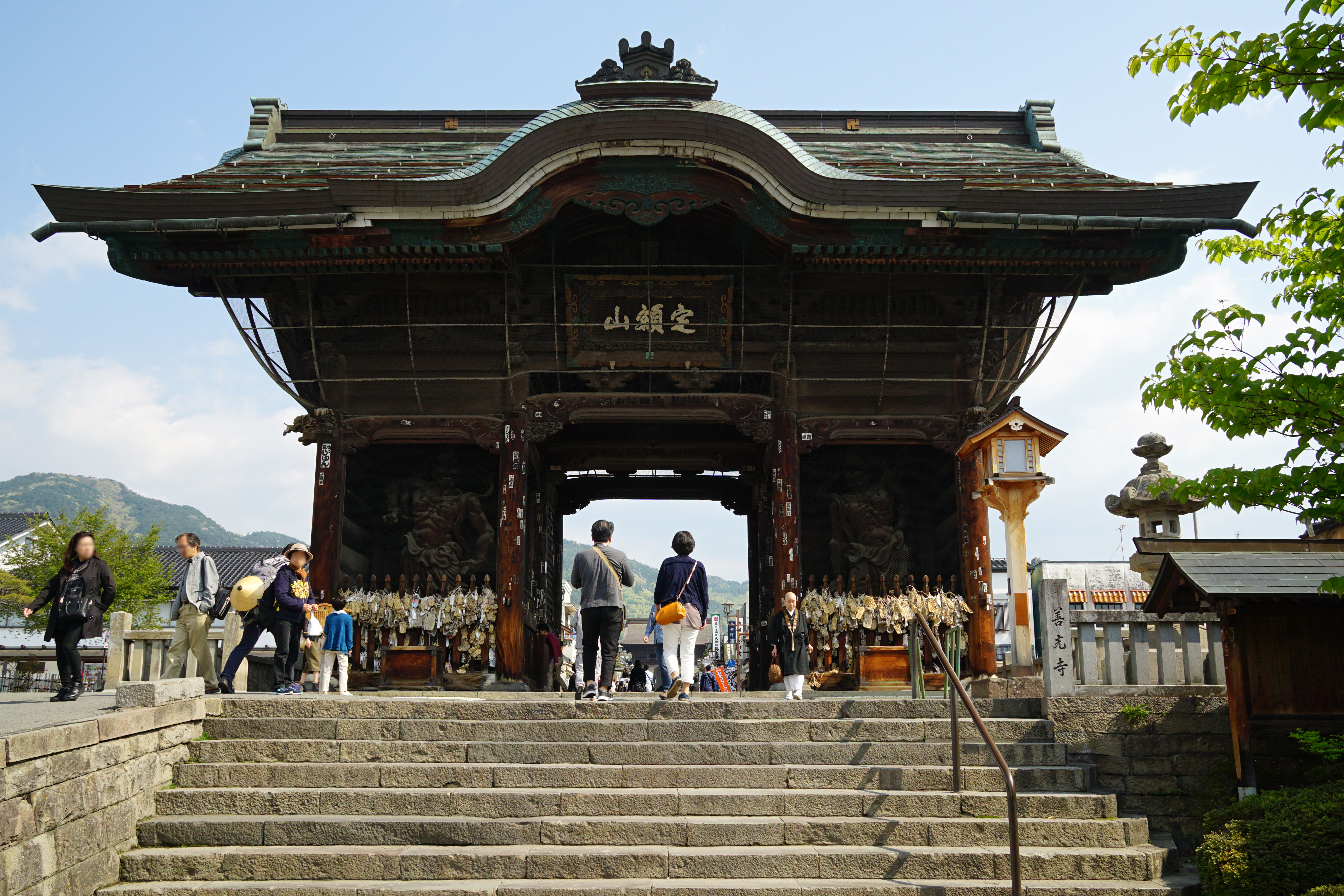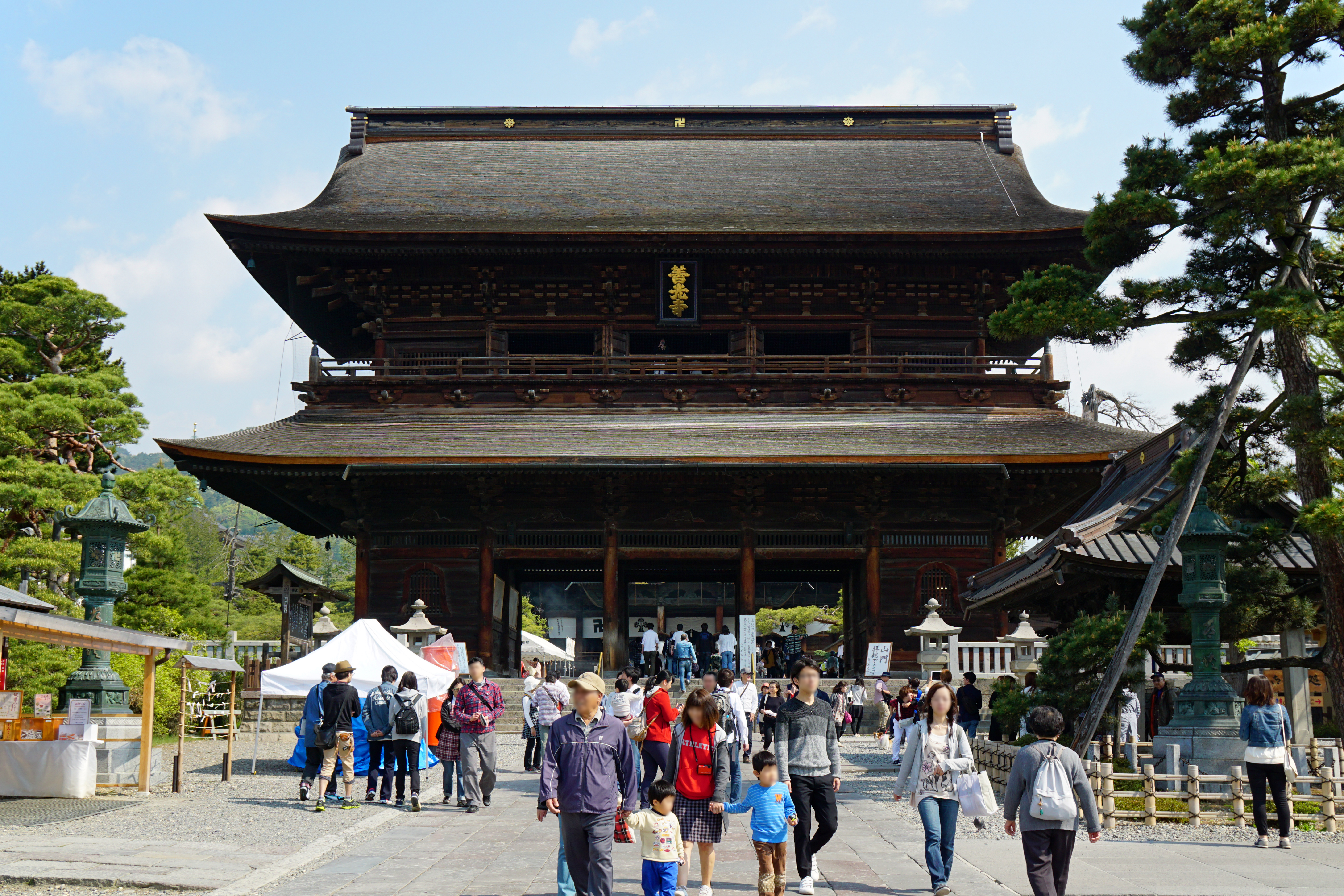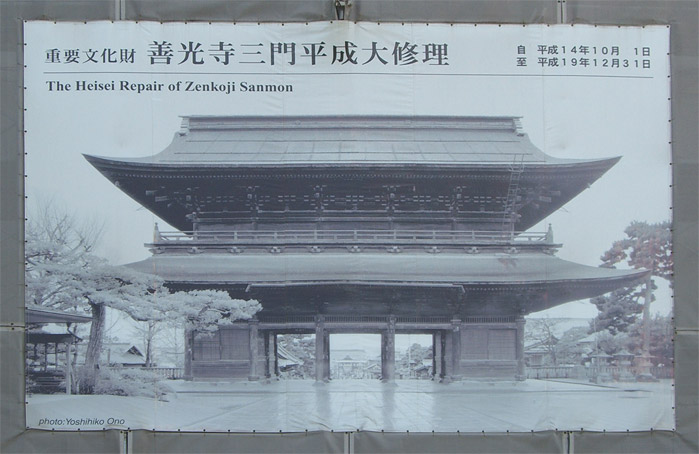Zenkō-ji on:
[Wikipedia]
[Google]
[Amazon]
 is a
is a
Japanese temple sprayed with graffiti after withdrawing from Olympic torch relay
 The Zenkō-ji compound contains many interesting and historically significant buildings. The compound is arranged in a linear fashion, from the south to the north, so that worshipers and visitors would likely see the buildings in this order. Admission to most of the buildings at the compound is covered by a ticket which costs ¥500. The ticket can be re-used at different buildings.
The Zenkō-ji compound contains many interesting and historically significant buildings. The compound is arranged in a linear fashion, from the south to the north, so that worshipers and visitors would likely see the buildings in this order. Admission to most of the buildings at the compound is covered by a ticket which costs ¥500. The ticket can be re-used at different buildings.
 The Niōmon gate features two impressive Niō guardians, which protect the compound from enemies of Buddhism. The two statues were reconstructed in 1918 after a fire.
The Niōmon gate features two impressive Niō guardians, which protect the compound from enemies of Buddhism. The two statues were reconstructed in 1918 after a fire.
 The Rokujizō are located to the right of the Daikanjin. The Rokujizō are statues of the six Bodhisattvas, who gave up Buddhist enlightenment, in order to provide salvation to others. The Bodhisattvas are said to be able to commune with the six realms of hell, starvation, beasts, carnage, human beings and divine beings.
The Rokujizō are located to the right of the Daikanjin. The Rokujizō are statues of the six Bodhisattvas, who gave up Buddhist enlightenment, in order to provide salvation to others. The Bodhisattvas are said to be able to commune with the six realms of hell, starvation, beasts, carnage, human beings and divine beings.


 The
The
 The
The

 This is the Main Hall, located at the northern end of the compound. It is considered a National Treasure.
This is the Main Hall, located at the northern end of the compound. It is considered a National Treasure.
Zenkō-ji Official Site (Japanese)
This is an excellent overview of Zenkō-ji, with many good photographs. {{DEFAULTSORT:Zenko-Ji Buddhist temples in Nagano Prefecture 644 establishments Tendai temples Jōdo-shū Buildings and structures in Nagano (city) National Treasures of Japan Religious buildings and structures completed in the 640s 7th-century Buddhist temples Temples of Amitābha Important Cultural Properties of Nagano Prefecture Jōdo-shū temples 7th-century establishments in Japan
 is a
is a Buddhist temple
A Buddhist temple or Buddhist monastery is the place of worship for Buddhism, Buddhists, the followers of Buddhism. They include the structures called vihara, chaitya, stupa, wat, khurul and pagoda in different regions and languages. Temples in B ...
located in the city of Nagano, Japan
Japan is an island country in East Asia. Located in the Pacific Ocean off the northeast coast of the Asia, Asian mainland, it is bordered on the west by the Sea of Japan and extends from the Sea of Okhotsk in the north to the East China Sea ...
. The temple was built in the 7th century. It is one of the few remaining pilgrimage sites in Japan. The modern city of Nagano began as a town built around the temple.
Zenkō-ji was founded before Buddhism
Buddhism, also known as Buddhadharma and Dharmavinaya, is an Indian religion and List of philosophies, philosophical tradition based on Pre-sectarian Buddhism, teachings attributed to the Buddha, a wandering teacher who lived in the 6th or ...
in Japan split into several different sects. It currently belongs to both the Tendai
, also known as the Tendai Dharma Flower School (天台法華宗, ''Tendai hokke shū,'' sometimes just ''Hokkeshū''), is a Mahāyāna Buddhist tradition with significant esoteric elements that was officially established in Japan in 806 by t ...
and Jōdoshū schools of Mahayana Buddhism
Mahāyāna ( ; , , ; ) is a term for a broad group of Buddhist traditions, texts, philosophies, and practices developed in ancient India ( onwards). It is considered one of the three main existing branches of Buddhism, the others being Thera ...
, and is co-managed by twenty-five priests from the former school, and fourteen from the latter. The temple enshrines images of the Amida Buddha. According to legend, the image, having caused dispute between two clans, was dumped into a canal. It was later rescued by Honda Yoshimitsu. The temple was thus named "Zenkō," according to the Chinese transliteration of Yoshimitsu's name.
The main Buddhist image is a ''hibutsu (secret Buddha)'', a hidden Buddha statue, not shown to the public. This ''hibutsu'' is rumored to be the first Buddha statue to ever be brought to Japan. The commandments of the temple require the absolute secrecy of the statue, prohibiting it to be shown to anyone, including the chief priest of the temple. However, a replica of the statue (''Maedachi Honzon'') has been created which can be shown publicly once every six years in spring, in a ceremony called Gokaichō. This event attracts many worshippers and visitors. When the statue was on display in 2003, Zenkō-ji cooperated with Motozenkō-ji and Zenkō-ji of Kofu, Yamanashi Prefecture
is a prefecture of Japan located in the Chūbu region of Honshu. Yamanashi Prefecture has a population of 787,592 (1 February 2025) and has a geographic area of 4,465 km2 (1,724 sq mi). Yamanashi Prefecture borders Saitama Prefecture to the n ...
. The most recent display of "Maedachi Honzon" lasted from the beginning of April to the end of June, 2022. It was originally scheduled to be displayed in 2021 but was delayed due to the COVID-19 pandemic
The COVID-19 pandemic (also known as the coronavirus pandemic and COVID pandemic), caused by severe acute respiratory syndrome coronavirus 2 (SARS-CoV-2), began with an disease outbreak, outbreak of COVID-19 in Wuhan, China, in December ...
. The public showing period was also extended from the originally planned 57 days to 88 days with the goal of curbing the number of concurrent visitors.
The temple contains a statue of Binzuru, a physician who was said to be Buddha's follower. Visitors to the temple touch the statue in order to cure their ailments. The temple also contains an inner prayer chamber, accessible to visitors. Currently, a daily morning ritual is held there by the high priest or priestess. From the inner chamber, a narrow staircase leads down to a completely dark corridor. In this corridor worshippers try to touch a metal key hanging on the wall, in order to gain enlightenment. The key represents the Key to the Western Paradise of the Amida Buddha.
In the battles between Uesugi Kenshin
, later known as , was a Japanese ''daimyō'' (magnate). He was born in Nagao clan, and after adoption into the Uesugi clan, ruled Echigo Province in the Sengoku period of Japan. He was one of the most powerful ''daimyō'' of the Sengoku period ...
and Takeda Shingen
was daimyō, daimyo of Kai Province during the Sengoku period of Japan. Known as "the Tiger of Kai", he was one of the most powerful daimyo of the late Sengoku period, and credited with exceptional military prestige. Shingen was based in a p ...
in the 16th century, Zenkō-ji served as one of Kenshin's bases of operations.
History
According to the explanation of Zenkō-ji, the '' Hibutsu,'' or the main hidden icon, of Zenkō-ji, moved from India to Japan by way of the Korean peninsula, in the 6th century, during the reign ofEmperor Kinmei
was the 29th emperor of Japan,Imperial Household Agency (''Kunaichō'') 欽明天皇 (29) retrieved 2013-8-22. according to the traditional order of succession. Titsingh, Isaac. (1834)pp. 34–36 Brown, Delmer. (1979) ''Gukanshō,'' pp. 261–2 ...
. Afterwards, it was moved several times before coming to rest at its present location in Nagano city.
At the end of the Kamakura period
The is a period of History of Japan, Japanese history that marks the governance by the Kamakura shogunate, officially established in 1192 in Kamakura, Kanagawa, Kamakura by the first ''shōgun'' Minamoto no Yoritomo after the conclusion of the G ...
(1185–1333), many temples copied Zenkō-ji's famous Buddha statue, and many new temples were built around the country, calling themselves "Zenkō-ji" or "Shin-Zenkō-ji" ("New Zenkō-ji").
In the Sengoku period
The was the period in History of Japan, Japanese history in which civil wars and social upheavals took place almost continuously in the 15th and 16th centuries. The Kyōtoku incident (1454), Ōnin War (1467), or (1493) are generally chosen as th ...
(mid-15th to 17th century), when the Zenkō-ji became embroiled in the struggles between Uesugi Kenshin
, later known as , was a Japanese ''daimyō'' (magnate). He was born in Nagao clan, and after adoption into the Uesugi clan, ruled Echigo Province in the Sengoku period of Japan. He was one of the most powerful ''daimyō'' of the Sengoku period ...
and Takeda Shingen
was daimyō, daimyo of Kai Province during the Sengoku period of Japan. Known as "the Tiger of Kai", he was one of the most powerful daimyo of the late Sengoku period, and credited with exceptional military prestige. Shingen was based in a p ...
, the chief abbot was afraid it would be burnt to the ground. He built a new Zenkō-ji in what is now Kōfu
is the capital Cities of Japan, city of Yamanashi Prefecture, Japan. , the city had an estimated population of 187,985 in 90,924 households, and a population density of 880 persons per km2. The total area of the city is .
Overview Toponymy
Kōfu ...
; it stands to this day.
In 1598, Toyotomi Hideyoshi
, otherwise known as and , was a Japanese samurai and ''daimyō'' (feudal lord) of the late Sengoku period, Sengoku and Azuchi-Momoyama periods and regarded as the second "Great Unifier" of Japan.Richard Holmes, The World Atlas of Warfare: ...
moved the ''hibutsu'' to Kyoto
Kyoto ( or ; Japanese language, Japanese: , ''Kyōto'' ), officially , is the capital city of Kyoto Prefecture in the Kansai region of Japan's largest and most populous island of Honshu. , the city had a population of 1.46 million, making it t ...
, and then to Shinano. The ''hibutsu'' and the Zenkoji temple itself have since been moved back to Nagano.
Zenkō-ji temple decided to pull out of the 2008 Summer Olympics torch relay
The 2008 Summer Olympics torch relay was run from March 24 until August 8, 2008, prior to the 2008 Summer Olympics, with the theme of "one world, one dream". Plans for the relay were announced on April 26, 2007, in Beijing, China. The relay, a ...
, in relation with the 2008 Tibetan unrest
The 2008 Tibetan unrest, also referred to as the 2008 Tibetan uprising in Tibetan media, was a series of protests and demonstrations over the Government of China, Chinese government's treatment and persecution of Tibetan people, Tibetans. Protes ...
and in solidarity with the Tibetan Buddhists. The Zenkō-ji temple was then vandalized.Inside the compound
 The Zenkō-ji compound contains many interesting and historically significant buildings. The compound is arranged in a linear fashion, from the south to the north, so that worshipers and visitors would likely see the buildings in this order. Admission to most of the buildings at the compound is covered by a ticket which costs ¥500. The ticket can be re-used at different buildings.
The Zenkō-ji compound contains many interesting and historically significant buildings. The compound is arranged in a linear fashion, from the south to the north, so that worshipers and visitors would likely see the buildings in this order. Admission to most of the buildings at the compound is covered by a ticket which costs ¥500. The ticket can be re-used at different buildings.
Daihongan
Immediately on the left, from the southern entrance, this Jōdo Sect temple houses the nunnery and the residence of the high priestess.Niōmon
 The Niōmon gate features two impressive Niō guardians, which protect the compound from enemies of Buddhism. The two statues were reconstructed in 1918 after a fire.
The Niōmon gate features two impressive Niō guardians, which protect the compound from enemies of Buddhism. The two statues were reconstructed in 1918 after a fire.
Original Main Hall
The original Main Hall is located on the left, after the Niōmon gate.Daikanjin
Located on the left, after the original Main Hall site, this Tendai Sect temple houses the residence of the chief priest. The temple's compound contains a garden and a treasure house, which contains the illustrated scroll of ''The Tale of Genji
is a classic work of Japanese literature written by the noblewoman, poet, and lady-in-waiting Murasaki Shikibu around the peak of the Heian period, in the early 11th century. It is one of history's first novels, the first by a woman to have wo ...
''. These areas are not open for public viewing.
Rokujizō
 The Rokujizō are located to the right of the Daikanjin. The Rokujizō are statues of the six Bodhisattvas, who gave up Buddhist enlightenment, in order to provide salvation to others. The Bodhisattvas are said to be able to commune with the six realms of hell, starvation, beasts, carnage, human beings and divine beings.
The Rokujizō are located to the right of the Daikanjin. The Rokujizō are statues of the six Bodhisattvas, who gave up Buddhist enlightenment, in order to provide salvation to others. The Bodhisattvas are said to be able to commune with the six realms of hell, starvation, beasts, carnage, human beings and divine beings.
Sanmon


 The
The Sanmon
A or is the most important mon of a Japanese Zen Buddhist temple, and is part of the Zen '' shichidō garan'', the group of buildings that forms the heart of a Zen Buddhist temple.JAANUS It can be often found in temples of other denominations ...
Gate is considered an Important Cultural Property. It contains five wooden Buddhist statues (not available for public viewing), as well as a plaque with calligraphy by the Imperial prince, which is said to contain five hidden doves in the lettering. Reconstruction of the Sanmon Gate began on October 1, 2002 and was scheduled to end on December 31, 2007.
Kyōzō
 The
The Kyōzō
in Japanese Buddhist architecture is a repository for sūtras and chronicles of the temple history. It is also called , , or . In ancient times the ''kyōzō'' was placed opposite the shōrō, belfry on the east–west axis of the temple. The ea ...
is located on the far left from the Sanmon Gate. It is also an Important Cultural Property. The building contains a repository of printed Buddhist sutras, and visitors get to rotate the octagonal sūtra holder, in order to gain enlightenment. The Kyōzō
in Japanese Buddhist architecture is a repository for sūtras and chronicles of the temple history. It is also called , , or . In ancient times the ''kyōzō'' was placed opposite the shōrō, belfry on the east–west axis of the temple. The ea ...
was constructed in 1759, although the sūtra holder was made in 1694.
Zenkō-ji Hon-dō

 This is the Main Hall, located at the northern end of the compound. It is considered a National Treasure.
This is the Main Hall, located at the northern end of the compound. It is considered a National Treasure.
References
Further reading
* * Graham, Patricia J. (2007) ''Faith and Power in Japanese Buddhist Art'' (Honolulu:University of Hawaii Press
A university () is an institution of tertiary education and research which awards academic degrees in several academic disciplines. ''University'' is derived from the Latin phrase , which roughly means "community of teachers and scholars". Uni ...
) .
External links
Zenkō-ji Official Site (Japanese)
This is an excellent overview of Zenkō-ji, with many good photographs. {{DEFAULTSORT:Zenko-Ji Buddhist temples in Nagano Prefecture 644 establishments Tendai temples Jōdo-shū Buildings and structures in Nagano (city) National Treasures of Japan Religious buildings and structures completed in the 640s 7th-century Buddhist temples Temples of Amitābha Important Cultural Properties of Nagano Prefecture Jōdo-shū temples 7th-century establishments in Japan